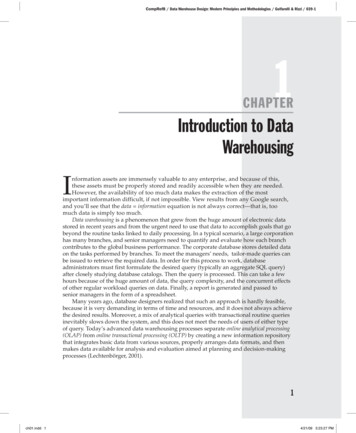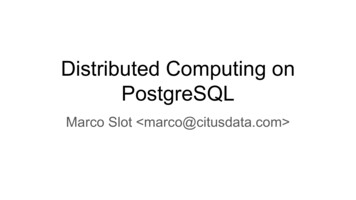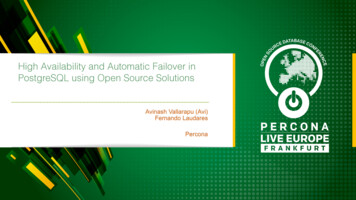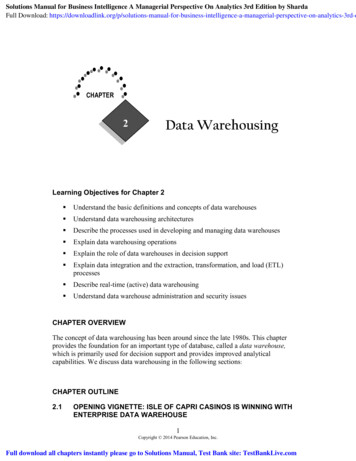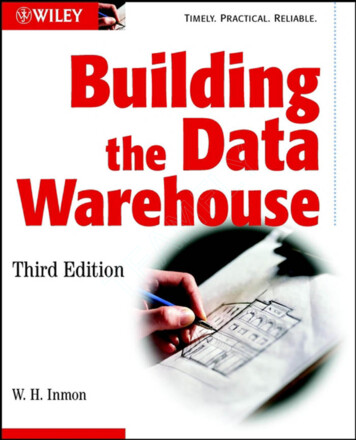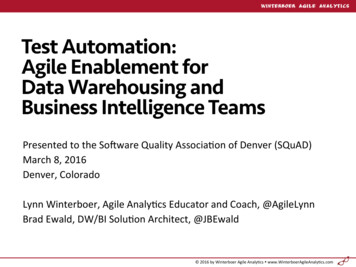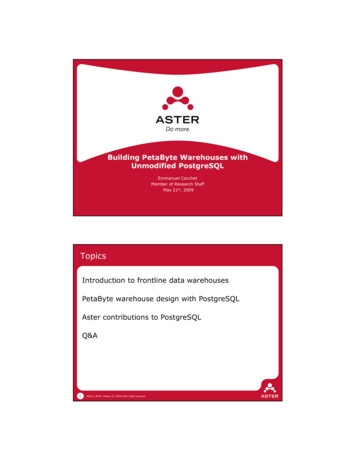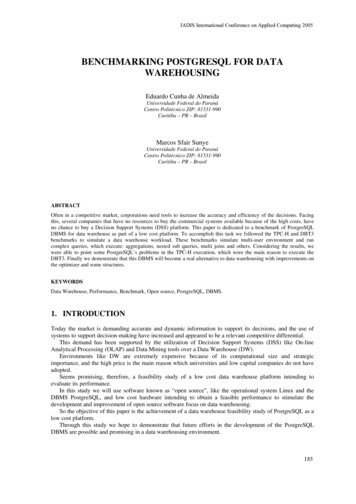
Transcription
IADIS International Conference on Applied Computing 2005BENCHMARKING POSTGRESQL FOR DATAWAREHOUSINGEduardo Cunha de AlmeidaUniversidade Federal do ParanáCentro Politécnico ZIP: 81531-990Curitiba – PR – BrasilMarcos Sfair SunyeUniversidade Federal do ParanáCentro Politécnico ZIP: 81531-990Curitiba – PR – BrasilABSTRACTOften in a competitive market, corporations need tools to increase the accuracy and efficiency of the decisions. Facingthis, several companies that have no resources to buy the commercial systems available because of the high costs, haveno chance to buy a Decision Support Systems (DSS) platform. This paper is dedicated to a benchmark of PostgreSQLDBMS for data warehouse as part of a low cost platform. To accomplish this task we followed the TPC-H and DBT3benchmarks to simulate a data warehouse workload. These benchmarks simulate multi-user environment and runcomplex queries, which execute: aggregations, nested sub queries, multi joins and others. Considering the results, wewere able to point some PostgreSQL’s problems in the TPC-H execution, which were the main reason to execute theDBT3. Finally we demonstrate that this DBMS will become a real alternative to data warehousing with improvements onthe optimizer and some structures.KEYWORDSData Warehouse, Performance, Benchmark, Open source, PostgreSQL, DBMS.1. INTRODUCTIONToday the market is demanding accurate and dynamic information to support its decisions, and the use ofsystems to support decision-making have increased and appeared to be a relevant competitive differential.This demand has been supported by the utilization of Decision Support Systems (DSS) like On-lineAnalytical Processing (OLAP) and Data Mining tools over a Data Warehouse (DW).Environments like DW are extremely expensive because of its computational size and strategicimportance, and the high price is the main reason which universities and low capital companies do not haveadopted.Seems promising, therefore, a feasibility study of a low cost data warehouse platform intending toevaluate its performance.In this study we will use software known as “open source”, like the operational system Linux and theDBMS PostgreSQL, and low cost hardware intending to obtain a feasible performance to stimulate thedevelopment and improvement of open source software focus on data warehousing.So the objective of this paper is the achievement of a data warehouse feasibility study of PostgreSQL as alow cost platform.Through this study we hope to demonstrate that future efforts in the development of the PostgreSQLDBMS are possible and promising in a data warehousing environment.185
ISBN: 972-99353-6-X 2005 IADISUsing the open source model we hope to feed the interest in the development of another components of adata warehouse environment, like: On-Line Analytical Processing (OLAP) e Extract, Transform and Load(ETL).Although this study focus a performance feasibility of a DBMS and a operational system with a low costhardware, are also presented some briefs considerations about others data warehouse components that caninfluence in the final cost and performance results, as well as others quotations of studies made about DBMS.In the performance measuring we will use the methodologies developed by the Open SourceDevelopment Lab (OSDL) and by the Transactional Processing Performance Council (TPC) and we willexplain why it was necessary two different methodologies.The paper is divided in four chapters, as follow: chapter two describes the data warehouse concept, thehistory and characteristics of PostgreSQL and some implementations which can increase the performance ofPostgreSQL, chapter three describes the results and chapter four presents the conclusion.2. POSTGRESQL AND DATA WAREHOUSE2.1 Data WarehouseData Warehouse uses a methodology to integrate transactional databases into a new database. This newdatabase stores all the company history and became a strategic tool to increase results and optimizeinvestments of the companies.Compared with transactional databases this kind of database has a different workload. DW just executes“SELECT”queries and the loading usually happens in certain periods (once a day, week or month).The loading are usually big transactions because imports large amount of data from several sources. SomeDW environments import millions of rows daily, like telecommunications companies.2.2 PostgreSQLPostgreSQL is the most advanced open-source database available anywhere. PostgreSQL came from IngresDBMS [Drake, J.D. et al 2002].The main characteristics of PostgreSQL are: referential integrity, lots of interfaces (ODBC, JDBC, PHP,and others), SQL92 e SQL99 specifications support, procedural languages support (Perl, Python, TCL andothers), concurrence control avoiding read block when a write occurs and write control by writing in logbefore disk.The optimizer uses statistics and several algorithms to execute queries. It has a genetic algorithm thatmakes different execution steps to the same query and then chose the best one. PostgreSQL query executionrun as follow, according to [Lane, T. 2000], and can be visualized in the figure 1.Figure 1. PostgreSQL query execution186
IADIS International Conference on Applied Computing 2005Executions steps into the optimizer:1 - The query is submitted to the parser that verifies the object’s definitions using the data dictionary;2 - The query is rewrite;3 - The planner builds an execution plan guided by the new query, the database statistics retrieved by theDBA and a genetic algorithm that generate several execution plan and chose the best one;4 - The execution plan is executed.In this work we use PostgreSQL 7.4.2. In the next version, 8, it will be implemented two features that canincrease the DBMS performance. The features are: Multi-column index statistics. This achievement can dramatically increases some queriesperformance that we have run in this work, because large tables and complex queries use suchindex; Tablespaces that help the organization of large databases, distributing the object storage. Thisdistribution can split data files and index files in different locations, decreasing the concurrency inI/O operations.We suggest some implementations that can be done in PostgreSQL considering DW are: PAX (Partition Attribute Across) page strategy implementation purposed by [Ailamaki A.; et al,1988]; Encoded bitmap indexes purposed by [Wu, M. C. et al, 1998]; Intra-query parallelism described by [Omiecinski, E. 1995].These implementations can increase dramatically the performance of PostgreSQL based on the paper’sresults. PAX groups each attribute into mini blocks. Query’s performance increases 11% to 42% with thiskind of page strategy. The other improvement is a kind of grouping index called bitmap index. Bitmap index increasesgrouping queries and become a good choice to be implemented into low cardinalities attributes. Ifwe consider just the encoded bitmap index implementation we can see the good performance resultsthat Sybase IQ and MS SQL Server show in the TPC-H benchmark. Some papers and vendorsrecommend that bitmap index can be used into attributes with 0.1% of cardinality, which is 0.1% ofall existent rows. Some DBMS like Sybase IQ implements specific grouping index depending onattribute cardinalities not just to the recommendation above. Considering the PostgreSQL’s open source characteristic we can think about the quality, low costand freedom to change the source code as needed. Quality because the open source community isalways concern about bug corrections in commitment with the rest of the community and low costcharacteristic because the values of DBMS in Data Warehouse projects are almost 50% of thevalues of the entire project.3. RESULTSThe benchmark execution begins with TPC-H that is the basis of this paper, after TPC-H we executed DBT3.First we executed TPC-H 100 GB scale then the 1GB scale and finally the DBT3 1GB because of theresults.The environment configuration is: OSDL DBT3 version 1.4 and TPC-H version 2.0.0; Scale factor 1GBand 100GB; Loading using flat files.Softwares used are: PostgreSQL 7.4.2; Mandrake Linux 64bits (kernel 2.6.5); Java SDK 1.4.2 04;PostgreSQL JDBC pg74.1jdbc3.jar; TPC-H utilities (DBGEN and QGEN)Hardware used is: Dual Opteron 64bits Model 240 1.4GHz; 4 GB RAM; 960 GB Disk RAID 0.The programs to load the database and the execution of the TPC-H benchmark were written in JAVA andshell script. The DBT3 benchmark was executed by the package provide by OSDL.JavaSDK 32-bits version was used because Sun Microsystems does not provide an AMD Opteron stable64-bits version until the beginning of this work and became a reason to compile the Linux kernel with 32-bitssupport.187
ISBN: 972-99353-6-X 2005 IADISWe load the database three times using kernel the versions 2.4.24 and 2.6.5 to measure the differencesand retrieve maximum performance from the system. First we created a monolithic script that is a scriptwithout load balance.Analyzing these times we decided to use the kernel version 2.6.5 and split the script to use bothprocessors.The load balance is divided in two. The first part build LINEITEM table and the second part build the restof the database.We achieved an improvement of 32 % using a 64-bits OS and the kernel version 2.6.x compared to a 32bits OS and kernel 2.4.x in the loading phase.Compared to the Sybase IQ with a similar environment we have a 70% less performance in the loadingphase, but 86,16 % less cost.The Sybase IQ environment described into TPC website costs US 45.021 and takes 6:16:00 hours to loadthe 100 GB database on a similar machine.The Table 1 shows the loading results and the figure 2 shows the TPC-H results.Table 1. Loading resultsDistributionDebian 32bitsMandrake 64bitsMandrake 64bitsMandrake 64bitsTimes(Hr)Kernel Scale(GB) ScriptData load PK and index Total load time2.4.24100 Monolithic11:37:5912:22:0424:00:042.6.5100 Monolithic07:24:2313:42:3121:06:542.6.5100 Distributed06:14:3009:58:3116:13:012.6.51 11213141516171819202122RF1RF22,500QueryTPCH 100 GB - PostgreSQL 7.4.2Time (seconds)Figure 2. The power test resultSome queries run near or faster than Sybase and MS SQL Server like queries number 11 and 18.These queries run complex operations like sub-queries and sub-queries inside the HAVING clause.The queries that take the longest time shows PostgreSQL problems compared to another DBMS. Thesequeries number are 4, 8, 9, 10, 19, 20 and 22. The operations executed by these queries are: Sub-queries inside other sub-queries; EXISTS and NOT EXISTS operator; Aggregation with in-line view, that is sub-query inside the FROM clause; Selection by date.Most of these queries make the selection by date, which is a data warehouse regular use and DBMS likeSybase has specific type of indexes for this purpose.Another bottleneck that we have found is the optimizer.188
IADIS International Conference on Applied Computing 2005The optimizer creates an execution plan after the query rewrite based on the database statistics. Here wecan point two important factors: a periodic update of the statistics and the query rewrite.The first factor is the statistic update that we have made after the database load. This is enough to theexecution of the benchmark.The second factor is the query rewrite and this process is executed by the DBMS so its not possible tochange without verify the source code. In this case is better to change the SQL text before submit to thesystem and TPC-H does not allow this.We use the original queries in the beginning of the tests and some was abort by timeout, becausePostgreSQL does not generate a good execution plan. These problems just allow the execution of power test.Then we verify that the bad execution plans was generate because of the query rewrite, pointed as themajor update to the next PostgreSQL’s version.We can analyze in the query number 19 that the “join” operations and some selections are write insideeach “OR” operation. Into the rewritten query these common segments is left outside the “OR” operations.The optimizer without human assistance must do this kind of rewrite process. The new query was developedby OSDL for DBT3 benchmark and the texts are described in figure 3.QueryConsulta19 – TPC-Hversion19 - OriginalQuery19 19– OSDLversionConsulta- ReescritaSelect sum(l extendedprice* (1 - l discount)) as revenueSelect sum(l extendedprice* (1 - l discount)) as ep partkey l partkey(p partkey l partkeyand l shipmode in ('AIR', 'AIR REG')and p brand ‘[BRAND1]'and l shipinstruct 'DELIVER IN PERSON'and p container in ('SM CASE', 'SM BOX', 'SM PACK', 'SM PKG')and l quantity [QUANTITY1] and l quantity [QUANTITY1] 10and((and p size between 1 and 5p brand '[BRAND1]'and l shipmode in ('AIR', 'AIR REG')and p container in ('SM CASE', 'SM BOX', 'SM PACK', 'SM PKG')and l shipinstruct 'DELIVER IN PERSON'and l quantity [QUANTITY1] and l quantity [QUANTITY1] 10and p size between 1 and 5)or) or((p partkey l partkeyand p brand '[BRAND2]'p brand '[BRAND2]'and p container in ('MED BAG', 'MED BOX', 'MED PKG', 'MED PACK')and p container in ('MED BAG', 'MED BOX', 'MED PKG', 'MED PACK')and l quantity [QUANTITY2] and l quantity [QUANTITY2] 10and l quantity [QUANTITY2] and l quantity [QUANTITY2] 10and p size between 1 and 10and p size between 1 and 10and l shipmode in ('AIR', 'AIR REG'))orand l shipinstruct 'DELIVER IN PERSON'.)or.Figure 3. Query 19 textsWe decide to put an interruption timeout clause because of the bad plans generation. The time is 25000seconds.Analyzing the plans and the queries with the timeout parameter we were able to verify the problems ofthe DBMS.After we interrupt the queries by timeout, some of them were executed without this parameter. Evenwithout timeout the query number 19 must be interrupted because exceeded 72 hours of execution in the 100GB scale.In the 1 GB scale the same query was interrupted after 24 hours of execution without retrievingsomething. When the rewrite of this query was made the execution takes an average of 25,64 secondsconfirming the PostgreSQL optimizer problem more specifically in the query rewrite module.The execution plans are described in figure 4.189
ISBN: 972-99353-6-X 2005 IADISOriginal QueryAggregate (cost 672136305127.42.672136305127.43 rows 1 width 22)- Nested Loop (cost 7117.00.672136305127.15 rows 108 width 22)Join Filter: (.)Rewrited QueryAggregate (cost 288750.64.288750.64 rows 1 width 22)- Hash Join (cost 7617.00.288750.37 rows 104 width 22)Hash Cond: ("outer".l partkey "inner".p partkey)Join Filter: (.)Figure 4. Query 19 execution’s planJust to mention Sybase executes this query in the 100 GB scale in 971 seconds.It is not possible to compare the test results with TPC-H because the tests were stopped by timeout orinterrupted with some days of execution; in the last case it is unacceptable.Considering the situation above we decide to run the DBT3 benchmark, which considers modification inthe queries. In this condition PostgreSQL executed the 0150100Throughput50-QueryOSDL DBT3 1 GB - PostgreSQL 7.4.2Time (seconds)Figure 5. 1GB DBT3 Results graphThe measures generated by DBT3 are:Power@size 332,35Throughput@size 224,85Composite 273,37This result just can be compared to other OSDL result and is not conclusive to compare to another DBMSthat do not execute the OSDL benchmark.Table 2. Benchmark’s execution summaryTPC-HTPC-HDBT3Benchmark10011Scale (GB)Executed (*)StatusTimeout perTimeout query (sec)25.000Exec. eout Exec. Time 72Hr 24Hr2.482 sec(*) only power test190
IADIS International Conference on Applied Computing 20054. CONCLUSIONIn this work we executed benchmarks that test the low cost platform performance using PostgreSQL andLinux, pointing the problems and verifying if even considering the problems the platform is feasible.We also verify structures, which can increase the PostgreSQL’s performance.We have shown that PostgreSQL DBMS version 7.4.2 is not able to execute satisfactory TPC-Hbenchmark the reason why we executed DBT3 benchmark. Our feasibility expectations of a low cost datawarehouse with our environment were not fully reached.It is important to mention the considerable increase of the performance from version 7.3.4 to 7.4.2 withthe development of some aggregation features. Then we can expect, in a near future, to compared to anotherDBMS like Sybase and SQL Server. The differences can become shorter with the natural open sourcedevelopment and the implementation of the structures that we have suggested.We expected that PostgreSQL becomes a real alternative to data warehouse project in any scale in thenext version.The fix of the optimizer fix is considered crucial even with the development of the structure suggested inthis work and is the main improvement of the next version.To use PostgreSQL in a data warehouse project with the actual version 7.4.2 some reservations must beconsidered: The organization does not have resources to buy a DBMS more mature; Accept the low performance because of the problems pointed in this work; Constantly monitors the queries submitted to the system to verify if a rewrite is needed. In this caseif the number of users grows the cost of the manual rewrite grows too.The use of Linux OS can be assured in the TPC benchmarks and its use can bring very good results as wecan see in the TPC website.As future work we can suggest the development into PostgreSQL of some structures that can increase theperformance. These implementations are: PAX pages proposed by [Ailamaki A.; et al, 1988]. This strategy can decrease I/O operations asdescribed by the author; Bitmap index proposed by [Wu, M. C. et al, 1998]. This kind of index can increase aggregationqueries; Intra-query parallelism describe by [Omiecinski, E. 1995]. The parallelism can increase theperformance of sub-queries and in-line views that we have low performance in the PostgreSQL. The use of clusters, because this work uses a multi-processor server. The use of a cluster is a goodalternative when the processing power must be improved and has a low cost if compared to a multiprocessor machine; Development of a similar methodology to TPC-H and DBT3 to take advantages of object orientedfeatures of PostgreSQL.Other works that can be developed using the open source model to the other data warehouse’scomponents are: OLAP tool;ETL tool using the works proposed by [Jung, I. Et al, 2000] and [Kavalco, G. 2001]. REFERENCESAilamaki A.; et al, 1988. Weaving Relations for Cache Performance. Proceedings of the 27th International Conference ofVery Large Databases, Roma, Italy, 2001.Bell, D. A. Issues in Relational Database Performance. Data & Knowledge Engineering 3, pp 49-61, 1988.Bitton, D. et al, 1983. Benchmarking Database Systems A Systematic Approach. Proceedings of the InternationalConference of Very Large Databases, November 1983.Boral, H. et al, 1984. A Methodology for Database System Performance Evaluation. Proceedings of the 1984 SIGMODConference, June, 1984.Cannataro, M. et al, 2002. Parallel data intensive computing in scientific and commercial applications. Elsevier: ParallelComputing, pp 673-704, 2002191
ISBN: 972-99353-6-X 2005 IADISChan, C.Y. et al, 1998. Bitmap Index Design and Evaluation. Computer Science Dept., University of WisconsinMadison, 1998.Corey, M. et al, 2001. Oracle 8i Data Warehouse. Rio de Janeiro: Editora Campus Ltda.Drake, J.D. et al 2002. Practical PostgreSQL. Oreilly e Assoc.Elmasri, R. et al, 2000. Fundamentals of Database System. 3ª edição, California: Addison-Wesley Publishing.Ernst, B. et al 1999. Enterprise DBA Parte1:
POSTGRESQL AND DATA WAREHOUSE 2.1 Data Warehouse Data Warehouse uses a methodology to integr
